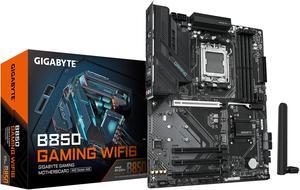
- Brand: GIGABYTE
- CPU Socket Type: AM5
- Chipset: AMD B850
- Form Factor: ATX
- Model #: B850 GAMING WF6
- Item #: N82E16813145548
- Return Policy: Standard Return Policy
Three NVME slots PCIE 5.0 for the latest GPUS PCIE 5.0 for the latest NVME down the road Lots of fan and argb headers Great thermal design Great easy to use Bios

- Memory Standard: Memory Support 7800+(OC)/ 7600(OC)/ 7400(OC)/ 7200(OC)/ 7000(OC)/ 6800(OC)/ 6600(OC)/ 6400(OC)/ 6200(OC)/ 6000(OC)/ 5800(OC)/ 5600(JEDEC)/ 5400(JEDEC)/ 5200(JEDEC)/ 5000(JEDEC)/ 4800(JEDEC) MHz Max. overclocking frequency: - 1DPC 1R Max speed up to 7800+ MHz - 1DPC 2R Max speed up to 6600+ MHz - 2DPC 1R Max speed up to 6400+ MHz - 2DPC 2R Max speed up to 5600+ MHz
- Number of Memory Slots: 4x288pin (DDR5)
- Audio Chipset: Realtek ALC4080 Codec 7.1-Channel USB High Performance Audio Supports up to 32-Bit/384 kHz playback on front panel
- Brand: MSI
- Model #: MAG Z790 TOMAHAWK MAX WIFI
- Item #: N82E16813144633
- Return Policy: Standard Return Policy
Excellent build quality, this motherboard is heavy in the box, I mean they have a few things that came with the board but man it is a heavy product. You pull it out of the plastic bag it comes in and you can feel the build quality and see it to. I've bought MSI products for years and I still have a Z87 board with a 4th gen cpu and also a 970 MSI video card and they both are still going strong to this day. The ease of building this new system with the new Tomahawk board is amazing, it's like putting a puzzle together and once you do it works perfectly every time. I've never had any problems with MSI equipment out of the box. I will post some pics soon to show the finished build.
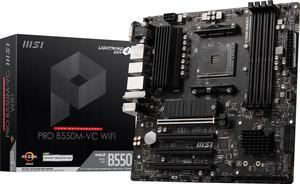
- Brand: MSI
- CPU Socket Type: AM4
- Chipset: AMD B550
- Serial ATA (SATA): 4x SATA 6Gb/s ports
- Model #: PRO B550M-VC WIFI
- Item #: N82E16813144548
- Return Policy: Standard Return Policy
Booted without needing to flash bios with Ryzen 5 5500
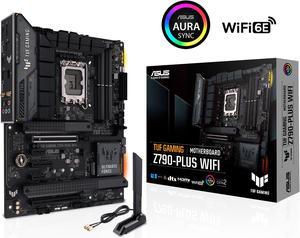
- Memory Standard: DDR5 7200(OC)/7000(OC)/6800(OC)/6600(OC)/ 6400(OC)/ 6200(OC)/ 6000(OC)/ 5800(OC)/ 5600/ 5400/ 5200/ 5000/ 4800 Non-ECC, Un-buffered Memory* Dual Channel Memory Architecture Supports Intel® Extreme Memory Profile (XMP) OptiMem II * Supported memory types, data rate (speed), and number of DRAM modules vary depending on the CPU and memory configuration, for more information please refer to CPU/Memory Support under the Support tab or visit https://www.asus.com/support/ * Non-ECC, un-buffered DDR5 memory supports On-Die ECC function.
- Number of Memory Slots: 4x288pin (DDR5)
- Brand: ASUS
- CPU Socket Type: LGA 1700
- Model #: TUF GAMING Z790-PLUS WIFI 6E
- Item #: N82E16813119618
- Return Policy: Standard Return Policy
Excellent bord so far, now that it works.
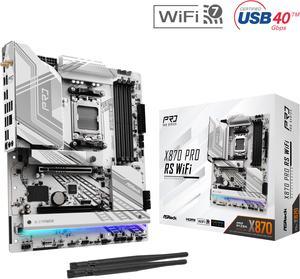
- Brand: ASRock
- CPU Socket Type: AM5
- Chipset: AMD X870
- Serial ATA (SATA): 6 x SATA 6Gb/s
- Model #: X870 Pro RS WiFi
- Item #: N82E16813162167
- Return Policy: Standard Return Policy
- Nice toolless design for the M.2 slots made it super easy to install - BIOS was easy to use and set up - WIFI works well. Fast and reliable so far!

- Brand: MSI
- CPU Socket Type: AM5
- Chipset: AMD X870E
- Serial ATA (SATA): 4 x SATA 6Gb/s
- Model #: MAG X870E TOMAHAWK WIFI
- Item #: 9SIBYT0KEM6755
- Return Policy: View Return Policy
- Bios is very simple but feature rich, my favorite layout of any vendor - No tools required to put M.2 drives in is very handy - PCie release button is nice - Solid stock bios settings and bios easy to update - Error code to diagnose problems

- Memory Standard: Support for DDR5 7600(O.C.) /7400(O.C.) /7200(O.C.) /7000(O.C.) /6800(O.C.) /6600(O.C.) / 6400(O.C.) / 6200(O.C.) / 6000(O.C.) / 5800(O.C.) / 5600(O.C.) / 5400(O.C.) / 5200(O.C.) / 4800 / 4000 memory modules Dual channel memory architecture Support for ECC Un-buffered DIMM 1Rx8/2Rx8 memory modules (operate in non-ECC mode) Support for non-ECC Un-buffered DIMM 1Rx8/2Rx8/1Rx16 memory modules Support for Extreme Memory Profile (XMP) memory modules
- Number of Memory Slots: 4x288pin (DDR5)
- Audio Chipset: Realtek Audio CODEC High Definition Audio
- Brand: GIGABYTE
- Model #: Z790 AORUS ELITE AX
- Item #: N82E16813145417
- Return Policy: Standard Return Policy
Easy setup. booted first time no issues.

- Brand: ASUS
- CPU Socket Type: AM4
- Chipset: AMD B550
- Serial ATA (SATA): 6 x SATA 6Gb/s
- Model #: PRIME B550-PLUS AC-HES
- Item #: N82E16813119665
- Return Policy: Standard Return Policy
Plug and play, right out of the box.
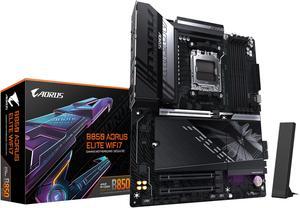
- Brand: GIGABYTE
- CPU Socket Type: AM5
- Chipset: AMD B850
- Form Factor: ATX
- Model #: B850 AORUS ELITE WF7
- Item #: N82E16813145545
- Return Policy: Standard Return Policy
The product basically makes sense. No bloat features or anything. Definitely recommend. I don't think I found any other product that had all the features within this price point. These are the things that I like about it. - It has PCIe Gen5 for both GPU and NVMe; you are all set for future proofing. - It has USB ports for days. It has USB C (10Gbps) in the back, 3 USB3.2 x2 Gen2, 4 USB3.2 x2 Gen1. - It has WiFi 7 and the antenna connector is so easy to use. Plug in and out. - It has a 2.5Gbps ethernet port. Lots of interesting file serving things to do with this. - It has an HDMI port next to where the front panel USB C connector is. I think it is for connecting a sensor panel if you want to put one in your case. - It has one of those convenient systems for unlatching your GPU and no-tool install for your M.2 drive. - It has good power delivery for your CPU so you can extract all your CPU has to offer. - It supports Q-Flash Plus; you just plug-in your thumb drive and hold the button and the board will automatically upgrade your firmware. - Good layout of pins on the board. They are all on the sides which makes cable management so easy. - It has an I/O shield which makes the build process tidy. - Aesthetically, the design just makes sense. It's just tasteful.
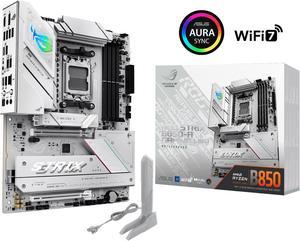
- Brand: ASUS
- CPU Socket Type: AM5
- Chipset: AMD B850
- Serial ATA (SATA): 2 x SATA 6Gb/s
- Model #: ROG STRIX B850-A GAMING WIFI
- Item #: N82E16813119703
- Return Policy: Standard Return Policy
Gorgeous motherboard, good quality build, all great.
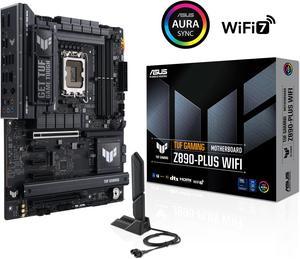
- Memory Standard: DDR5 4400 / DDR5 4800 / DDR5 5000 / DDR5 5200 / DDR5 5400 / DDR5 5600 / DDR5 5800 / DDR5 6000 / DDR5 6200 / DDR5 6400 / DDR5 6600 / DDR5 6800 / DDR5 7000 / DDR5 7200 / DDR5 7400 / DDR5 7600 / DDR5 7800 / DDR5 7900 / DDR5 7950 / DDR5 8000 / DDR5 8200 / DDR5 8266 / DDR5 8400 / DDR5 8600 / DDR5 8666 / DDR5 8800 / DDR5 8933 / DDR5 9000 / DDR5 9066
- Number of Memory Slots: 4x288pin (DDR5)
- Brand: ASUS
- CPU Socket Type: LGA 1851
- Model #: TUF GAMING Z890-PLUS WIFI
- Item #: N82E16813119695
- Return Policy: Standard Return Policy
Simple setup, worked and updated itself on first power up zero issues thus far. Massive heat sinks everywhere running benchmarks so far everything has been optimal. Nothing over 70c at 100% on processor,board, or video card. Wish I had known before hand they had heat sinks installed on the M.2 sockets for M1 M3 and M4. Wouldnt have had to buy memory with heat sinks. This is more positive than negative hence the pros column.
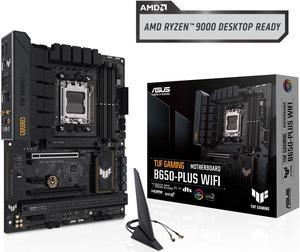
- Brand: ASUS
- CPU Socket Type: AM5
- Chipset: AMD B650
- Serial ATA (SATA): 4 x SATA 6Gb/s
- Model #: TUF GAMING B650-PLUS WIFI
- Item #: N82E16813119595
- Return Policy: Standard Return Policy
I just rebuilt my Desktop PC using the Asus TUF Gaming B50-Plus as the heart of the new system and, to this point (been running 24x7 for 2 weeks) it has provided everything I could have asked for. Three M.2 drive slots (and I use all three), plenty of IO options as well as ample fan and ARGB headers. It was compatible with my Ryzan 7800X3D out of the box, without the need to update the BIOS. And it has been stable from the first power on. I went with the 650 because I don't do a lot of overclocking, but, I wanted support for DDR5 RAM<, more than 2 M.2 drives and a host of USB available. This board does not disappoint. I highly recommend this motherboard.
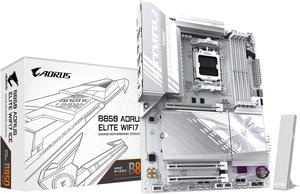
- Brand: GIGABYTE
- CPU Socket Type: AM5
- Chipset: AMD B850
- Form Factor: ATX
- Model #: B850 A ELITE WF7 ICE
- Item #: N82E16813145544
- Return Policy: Standard Return Policy
- Stunning all white motherboard - All white cables - Included WIFI
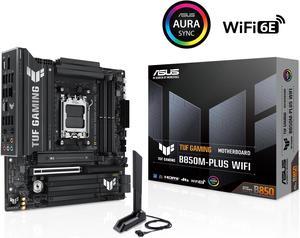
- Brand: ASUS
- CPU Socket Type: AM5
- Chipset: AMD B850
- Serial ATA (SATA): 4 x SATA 6Gb/s
- Model #: TUF GAMING B850M-PLUS WIFI
- Item #: N82E16813119706
- Return Policy: Standard Return Policy
- New chipset - Feels solid, good quality - Still has a comport which I like and use - Noctua NH-D12L fit no problem - Worked and no problem solving needed. Certainly won't detect some HW without drivers.

- Memory Standard: DDR5 5600 / DDR5 5800 / DDR5 6000 / DDR5 6200 / DDR5 6400 / DDR5 6600 / DDR5 6800 / DDR5 7000 / DDR5 7200 / DDR5 7400 / DDR5 7600 / DDR5 7800 / DDR5 7900 / DDR5 7950 / DDR5 8000 / DDR5 8200 / DDR5 8266 / DDR5 8400 / DDR5 8600 / DDR5 8800 / DDR5 8933 / DDR5 9066 / DDR5 9200 / DDR5 9466 / DDR5 9500
- Number of Memory Slots: 4x288pin (DDR5)
- Brand: GIGABYTE
- CPU Socket Type: LGA 1851
- Model #: Z890 AORUS PRO ICE
- Item #: N82E16813145524
- Return Policy: Standard Return Policy
The rgb on the motherboard looks really good the pcie button makes installing larger cards such as the 5090 much easier to do
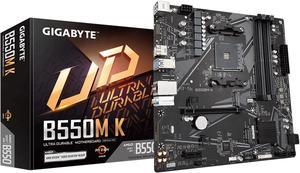
- Brand: GIGABYTE
- CPU Socket Type: AM4
- Chipset: AMD B550
- Serial ATA (SATA): 4 x SATA 6Gb/s
- Model #: B550M K
- Item #: N82E16813145434
- Return Policy: Standard Return Policy
quick easy set up no clutter. great that the m.2 slot has a pin instead of screw to hold it
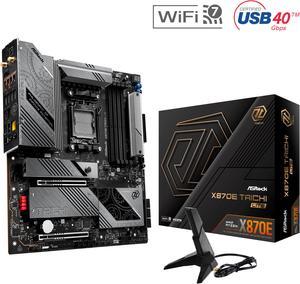
- Brand: ASRock
- CPU Socket Type: AM5
- Chipset: AMD X870E
- Serial ATA (SATA): 6 x SATA 6Gb/s
- Model #: X870E Taichi Lite
- Item #: N82E16813162162
- Return Policy: Standard Return Policy
EXPO memory profiles as well as PBO stable.
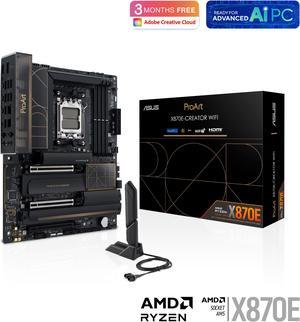
- Brand: ASUS
- CPU Socket Type: AM5
- Chipset: AMD X870
- Serial ATA (SATA): 4 x SATA 6Gb/s
- Model #: ProArt X870E-CREATOR WIFI
- Item #: N82E16813119688
- Return Policy: Standard Return Policy
the usual bots were lurking but was able to snag

- Memory Standard: Memory Support DDR5 6600+(OC)/ 6400(OC)/ 6200(OC)/ 6000(OC)/ 5800(OC)/ 5600(JEDEC)/ 5400(JEDEC)/ 5200(JEDEC)/ 5000(JEDEC)/ 4800(JEDEC) MHz Max. overclocking frequency: - 1DPC 1R Max speed up to 6600+ MHz - 1DPC 2R Max speed up to 6400+ MHz - 2DPC 1R Max speed up to 6000+ MHz - 2DPC 2R Max speed up to 5600+ MHz
- Number of Memory Slots: 4x288pin (DDR5)
- Audio Chipset: Realtek ALC897 Codec 7.1-Channel High Definition Audio Supports S/PDIF output
- Brand: MSI
- Model #: PRO Z790-S WIFI
- Item #: 9SIBMM4KH30998
- Return Policy: View Return Policy
It works. I've had the best luck with MSI boards working and not having to return them.
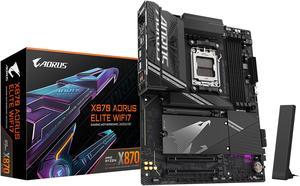
- Brand: GIGABYTE
- CPU Socket Type: AM5
- Chipset: AMD X870
- Serial ATA (SATA): 4 x SATA 6Gb/s
- Model #: X870 AORUS ELITE WIFI7
- Item #: N82E16813145519
- Return Policy: Standard Return Policy
I upgraded from a (MSxi) X570which was always very slow to get through the BIOS boot process (it took minutes). This was a defect, probably caused by the mobo searching for uninstalled hardware. This motherboard boots normally after the initial boot, which seemed to take forever. The physical layout is pretty standard. I like this motherboard, used with a Ryzen 9600X CPU. The Gen5 Samsung 990 EVO plus SSD runs off two CPU PCIe lanes (which the 990 Pro and EVO versions cannot do), leaving the full 16 lanes on the motherboard for the PCIe slots. I like the Ez-Latch feature on the NVME slot heatsinks - no tiny screws to lose. There's lots of USB back panel USB ports, and more on the board. It has only three PCIe slots - one 16 lane slot and two one-lane slots - enough for me - but my previous boards have had more. Heat sinks abound. Unlike some other boards I've used, the reset pin is in the lower right corner, where it's easy to reach. The board seems physically heavier than my previous boards. NOTE - while the 6 pin PCIe power connectors fit in an 8 pin supplementary power supply socket (backwards), but the polarity is reversed. And don't use accessory removable cables from other power supplies without first checking pin polarity. Cabling from different PS manufacturers is not necessarily interchangeable. Polarity may be reversed, even though the connectors are the same. I lost three backup hard drives when I over-volted them a few years back. Live and learn. Unlike with my previous boards, the learning curve for the AMI BIOS is fast. I found the BIOS easy to work with. I immediately upgraded the BIOS from within the BIOS, which was easy if you plug the flash drive (containing only the new BIOS file) into the correct USB port (marked BIOS). I put the f3 BIOS flash drive in the wrong USB port, and of course, the update failed. Read the manual first, which had to be downloaded from the Gigabyte website and printed out using my old computer. Avoid a heart attack. After installing a few core software programs, I played with the BIOS. I didn't overclock, but I did examine the BIOS pretty carefully. I like it. Unlike previous mobo's, this BIOS used the advertised CPU and memory speed ratings and settings on the initial boot. No BIOS changes were needed to get up to spec speeds. It also had some text to explain some of the features. The overclocking options are all there, but as with other BIOS's, they are buried pretty deep in the menu structure, so it takes some time to learn how to navigate through the advanced features of the BIOS. Overclocking can be simple with this (AMI) BIOS, or complex. Most of the advanced settings are set to Auto. Overall, I spent considerably less startup time with this BIOS than with previous BIOS's. Once you find out where to look, it's pretty easy to work with. It is adapted to varying levels of experience, so you can easily overclock automatically. If you are serious, you can play with the CPU and memory timings. Then I upgraded to Win 11, which was quick and easy. What a discouragement! Microsoft has done it again, making it more like a cell phone than ever before. It's more automated and for me, harder (almost impossible) to find the settings I work with within Windows. Nomenclature and procedures have changed for the worse - again. Even the Win FIle Manager has been altered for the worse. It's a giant riddle to do what I was used to doing in Win 10 without thinking. Like putting program icons on the desktop. Or changing the desktop background to a solid color. So I recovered Win 10 and installed "Classic Shell", which changes the look and feel to more like that of Win 7. At that point found I had no sound output even though Device Manager showed Sound as working properly. After trying to fix this with the Control Panel, which didn't work, I used the Gigabyte Control Center to install the Gigabyte sound drivers, downloaded from their website. No problemma. Five Stars+